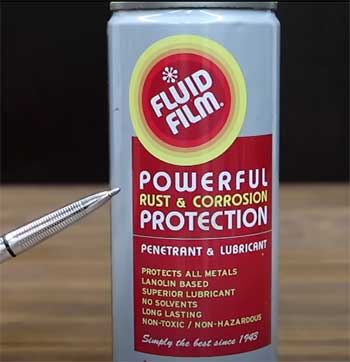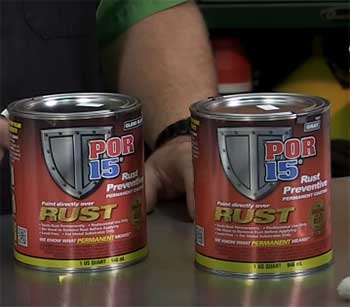If you’ve been battling rust for any length of time, you’re probably aware of the two leading contenders in the rust protection game: Fluid Film and POR-15. Today, we’re going to dive into the specifics of both products to help you make an informed decision about which one will work best for you.
In this comprehensive review, we’ll cover the pros and cons, the application process, longevity, and performance of each product.
A Brief Comparison Table
| Feature | Fluid Film | POR-15 |
| Application | Easy to apply with brush, spray, or hands | Requires careful surface preparation and multiple steps |
| Environmentally Friendly | Yes, made from natural ingredients | Contains chemicals that can be harmful if not used with proper safety precautions |
| Rust Conversion | No, primarily a rust preventative | Yes, converts existing rust into a hard, non-porous surface |
| Durability | Long-lasting protection, up to a year | Highly durable, abrasion-resistant coating once cured |
| High-Temperature Use | Not suitable for high-temperature applications | Suitable for use in high-temperature applications |
| Paintable | No, cannot be painted over | Yes, can be painted over for a seamless finish |
| Self-Healing | Yes, can “creep” into small spaces and self-heal | No, does not have self-healing properties |
| Price | Generally more affordable | Can be more expensive, depending on the application |
Fluid Film: The Natural Choice for Rust Prevention

Fluid Film is a lanolin-based rust preventative and lubricant that has been around for decades.
It’s non-toxic, eco-friendly, and easy to apply. The product’s main selling points are its long-lasting protection and self-healing properties, which make it ideal for use in harsh environments.
Pros of Fluid Film
- Environmentally friendly: Fluid Film is made from natural ingredients, which means it’s safe for the environment and won’t harm aquatic life.
- Easy application: You can apply Fluid Film with a brush, spray, or even just your hands.
- Long-lasting protection: Fluid Film offers a protective barrier that can last for up to a year in normal conditions.
- Self-healing: The product has the ability to “creep” into small spaces and self-heal when damaged, providing continuous protection against rust.
Cons of Fluid Film
- Not for high-temperature applications: Fluid Film is not suitable for use on exhaust systems or other high-temperature areas.
- Not paintable: You cannot paint over Fluid Film, which might be an issue if you want to match the protected area to the rest of your vehicle or equipment.
Also Read: Differences Between Fluid Film And PB Blaster.
POR-15: The Heavy-Duty Rust Converter and Coating
POR-15 is a high-performance, rust-converting coating that creates a rock-hard, non-porous surface. It’s designed to be applied directly to rusted metal, making it an excellent choice for use on vehicles, machinery, and other metal surfaces prone to rust.
Pros of POR-15
- Permanently seals rust: POR-15 doesn’t just prevent rust; it converts existing rust into a hard, non-porous surface.
- Highly durable: Once cured, POR-15 creates a tough, abrasion-resistant coating that can withstand harsh environments.
- Wide temperature range: POR-15 can be used in high-temperature applications, making it suitable for use on exhaust systems and other heat-generating components.
- Paintable: You can paint over POR-15, allowing you to create a seamless finish on your vehicle or equipment.
Cons of POR-15
- Application process: Applying POR-15 requires careful surface preparation and multiple steps, which can be time-consuming.
- Potentially hazardous: POR-15 contains chemicals that can be harmful if not used with proper safety precautions, such as gloves and adequate ventilation.
Comparing Fluid Film And POR-15 for Rust Protection

When it comes to rust protection, both Fluid Film and POR-15 have their unique strengths and weaknesses.
Fluid Film is an excellent choice for those looking for an eco-friendly, easy-to-apply solution that provides long-lasting protection.
On the other hand, POR-15 is better suited for those dealing with existing rust and needing a more permanent, heavy-duty solution that can withstand high temperatures and harsh conditions.
While both products offer effective rust protection, they serve different purposes and are best suited for different applications. If you’re looking for an all-around rust preventative that’s easy to apply and environmentally friendly, Fluid Film is your best bet.
If you need a heavy-duty rust converter and coating that can handle high temperatures and provide a durable, paintable surface, POR-15 is the clear winner.
Application Tips for Fluid Film and POR-15
To get the best results from both Fluid Film and POR-15, it’s crucial to follow the recommended application guidelines. Here are some tips to help you apply each product effectively:
Fluid Film Application Tips
- Clean the surface: Before applying Fluid Film, clean the surface to remove dirt, grease, and loose rust. A clean surface will allow the product to adhere better and provide more effective protection.
- Apply evenly: Spray or brush on an even coat of Fluid Film, ensuring complete coverage. You can also use your hands to apply the product, but be sure to wear gloves.
- Allow it to dry: Give Fluid Film time to dry and set. This usually takes about an hour, but it may take longer in colder or more humid conditions.
POR-15 Application Tips
- Prepare the surface: Thorough surface preparation is crucial for effective POR-15 application. Remove loose rust, dirt, and grease using a wire brush, sandpaper, or a suitable cleaner/degreaser.
- Apply a metal prep: Use a metal prep solution, such as POR-15 Metal Prep, to etch the surface and ensure better adhesion of the coating.
- Apply thin coats: Apply two to three thin coats of POR-15, allowing each coat to dry for at least two hours before applying the next one. This will ensure proper curing and a durable, long-lasting finish.
- Topcoat if necessary: If your project will be exposed to direct sunlight, apply a UV-resistant topcoat over the POR-15 to prevent sun damage.
FAQ Section
Fluid Film is primarily a rust preventative, meaning it works best when applied to clean, rust-free surfaces. While it can slow down the rusting process on already rusted surfaces, it doesn’t convert or seal existing rust like POR-15 does.
There are a few alternatives to POR-15 that provide similar rust-converting and sealing properties. Some popular options include Rust Bullet, KBS RustSeal, and Eastwood Rust Encapsulator. Each of these products has its own set of pros and cons, so it’s essential to research and compare them based on your specific needs.
Fluid Film’s longevity depends on the environmental conditions and the thickness of the application. In general, a single application of Fluid Film can provide protection for up to a year in normal conditions. However, if exposed to harsh environments or extreme weather, reapplication may be necessary more frequently.
Fluid Film stands out among rust preventatives for several reasons:
1. It’s made from natural ingredients, making it an eco-friendly and non-toxic option.
2. It’s easy to apply and doesn’t require any special equipment or surface preparation.
3. The product has self-healing properties, allowing it to maintain a continuous protective barrier even when damaged.
4. Fluid Film offers long-lasting protection against rust, often lasting up to a year in normal conditions.
These features make Fluid Film a top choice for those seeking a simple, effective, and environmentally friendly solution for rust prevention.
Yes, Fluid Film is a proven rust preventative that has been trusted by professionals and DIY enthusiasts alike for decades. Its unique formula provides a long-lasting barrier against moisture and corrosive elements, effectively preventing rust from forming on metal surfaces. With proper application, Fluid Film can keep your vehicle, machinery, and equipment protected from rust and corrosion for an extended period.
Also Read: Differences Between POR-15 And Eastwood Rust Encapsulator.
The Bottom Line
Ultimately, the choice between Fluid Film and POR-15 comes down to your specific needs and preferences. Both products offer effective rust protection, but they cater to different applications and situations.
Fluid Film is an excellent option for those looking for an easy-to-apply, eco-friendly, and long-lasting rust preventative. It’s ideal for general maintenance, undercoating vehicles, and protecting metal surfaces from moisture and corrosion.
On the other hand, POR-15 is better suited for heavy-duty applications where existing rust needs to be converted and sealed, and a durable, high-temperature-resistant coating is necessary. It’s perfect for restoring rusty vehicles, machinery, and equipment, as well as protecting high-heat components like exhaust systems.
By understanding the unique features and benefits of both Fluid Film and POR-15, you can make an informed decision about which rust protection product is best suited for your needs.



